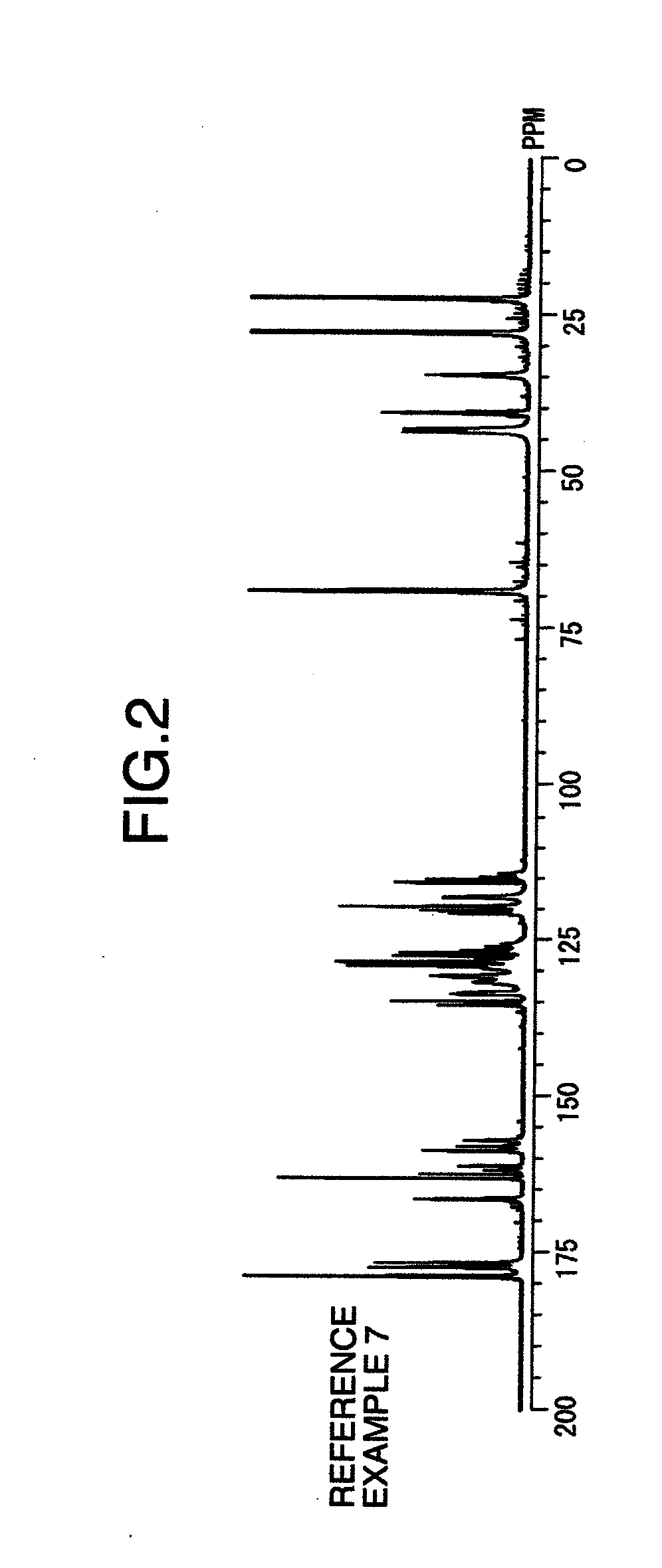Positive photosensitive resin composition
a technology of resin composition and photosensitive resin, which is applied in the direction of photosensitive materials, instruments, photomechanical equipment, etc., can solve the problems of inability to conduct heat treatment at such a high temperature, the mechanical properties of the obtained cured relief pattern are usually reduced, and the reliability cannot be obtained
- Summary
- Abstract
- Description
- Claims
- Application Information
AI Technical Summary
Benefits of technology
Problems solved by technology
Method used
Image
Examples
reference example 1
[0086]A four-necked, separable, glass flask provided with a stainless steel anchor stirrer was equipped with a Dean-Stark trap and a nitrogen inlet tube. The flask was heated by dipping in a silicon oil bath under stirring while passing nitrogen gas therethrough.
[0087]Charged together were 26.66 g (60 mmol) of 2,2-bis(3,4-dicarboxyphenyl)hexafluoropropane dianhydride (hereinafter referred to as “6FDA”), 10.8 g (50 mmol) of 3,3′-dihydroxy-4,4′-diaminobiphenyl (hereinafter referred to as “HO-AB”), 0.6 g (6 mmol) of γ-valerolactone, 1.8 g (18 mmol) of pyridine, 150 g of N-methylpyrrolidone (hereinafter referred to as “NMP”) and 30 g of toluene, and the resultant mixture was heated at a silicon oil bath temperature of 180° C. while passing nitrogen gas therethrough under stirring at 180 rpm for 1 hour and 40 minutes. During the reaction, distillate of toluene and water (toluene 25 g, water 3 g) was removed. An aliquot of this solution was diluted with NMP, and the molecular weight of th...
reference example 2
[0088]A four-necked flask equipped with a stirring rod, a Dean-Stark trap and a nitrogen inlet tube was charged with 14.89 g (60 mmol) of bicyclo(2,2,2)-oct-7-ene-2,3,5,6-tetracarboxylic dianhydride (manufactured by Aldrich, molecular weight of 248.19, hereinafter referred to as “BCD”) and 8.41 g (30 mmol) of (3-amino-4-hydroxyphenyl)sulfone (manufactured by Konishi Chemical Ind. Co., Ltd., molecular weight of 280.3, hereinafter referred to as “SO2—HOAB”). The system was charged with 0.9 g of γ-valerolactone and 1.44 g of pyridine as the catalyst, and 50 g of GBL and 30 g of toluene as the solvent. First, the mixture was stirred at 100 rpm for 20 minutes under a nitrogen atmosphere at room temperature, and then heating was started by dipping in a 180° C. oil bath. The entire solution was stirred at 180 rpm. During the reaction, water produced as a byproduct was eliminated by azeotropic distillation with toluene, and the water which accumulated at the bottom of the reflux tube was dr...
reference example 3
[0089]A polymer solution was produced using the same procedures as in Reference Example 2.
[0090]A four-necked flask equipped with a stirring rod, a Dean-Stark trap and a nitrogen inlet tube was charged with 14.89 g (60 mmol) of BCD and 8.41 g (30 mmol) of SO2-HOAB. The system was further charged with 0.9 g of γ-valerolactone and 1.44 g of pyridine as the catalyst, and 50 g of GBL and 30 g of toluene as the solvent. Then, the mixture was stirred at 100 rpm for 20 minutes under a nitrogen atmosphere at room temperature, and then heating was started by dipping in a 180° C. oil bath. The entire solution was stirred at 180 rpm. During the reaction, water produced as a byproduct was eliminated by azeotropic distillation with toluene, and the water which accumulated at the bottom of the reflux tube was drained off every 30 minutes. One hour after the heating started, the oil bath was removed to stop the heating. Stirring was continued at 180 rpm. After stirring for 30 minutes at room tempe...
PUM
| Property | Measurement | Unit |
|---|---|---|
| temperature | aaaaa | aaaaa |
| temperature | aaaaa | aaaaa |
| transparency | aaaaa | aaaaa |
Abstract
Description
Claims
Application Information
 Login to View More
Login to View More - R&D
- Intellectual Property
- Life Sciences
- Materials
- Tech Scout
- Unparalleled Data Quality
- Higher Quality Content
- 60% Fewer Hallucinations
Browse by: Latest US Patents, China's latest patents, Technical Efficacy Thesaurus, Application Domain, Technology Topic, Popular Technical Reports.
© 2025 PatSnap. All rights reserved.Legal|Privacy policy|Modern Slavery Act Transparency Statement|Sitemap|About US| Contact US: help@patsnap.com



